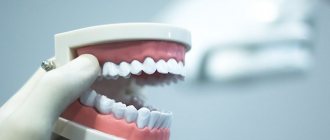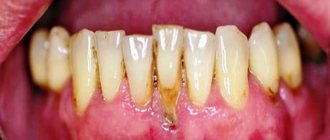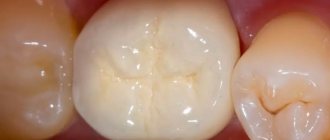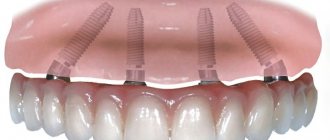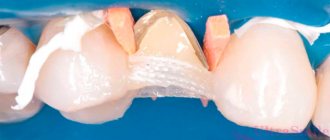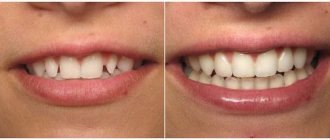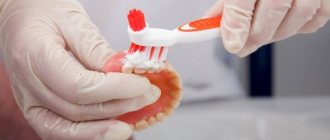A healthy tooth remains stable; slight fluctuation is acceptable due to the normal functioning of the periodontium. But the limits are minimal - no more than 100 microns. When pressed with your fingers, the vibrations are imperceptible and do not cause discomfort. But noticeable mobility indicates the development of a problem not only with the prosthesis, but also with the artificial root.
A dental implant is a complex structure for which the following types of prostheses are used:
- partially or completely removable;
- bridge-like permanents;
- fixed and conditionally removable crowns.
The implant consists of two elements:
- intraosseous part of conical-cylindrical, cylindrical, conical shape, perceiving loads;
- abutment as an intermediate link between the crown and the implant.
Damage to one of these elements or surrounding tissues leads to the fact that the dental system becomes loose and becomes mobile.
The ceramic lining on the crowns began to chip
The most likely cause is nocturnal bruxism. That is, in your sleep you clench your teeth and/or grind them uncontrollably. The reason for this is considered to be psychological stress.
Orthopedists often prescribe a night guard for these patients. Don't neglect her. It will cost money to have your teeth redone.
What to do? If you have these symptoms, your doctor will make a special night guard. It will need to be worn before bed to protect both the implants and teeth. At first it may cause slight discomfort.
Why do crowns fall off?
This unpleasant situation is caused by several reasons:
- Failure to comply with operating conditions when a person chews hard foods or gets carried away with viscous foods;
- Dental cement has become unusable;
- The crown has been worn out - the product has worn out and requires replacement;
- Mechanical injury;
- The crown is fixed with temporary cement and is not removed in a timely manner;
- Caries began under the crown of the tooth, breaking the tightness of the connection between the stump and the prosthesis;
- The crown does not match the ground tooth;
- Unsuitable prosthesis.
Implant maintenance has become too expensive for me
Once every six months, it is recommended to have your teeth and implants professionally cleaned by a hygienist. The procedure is not very expensive (3000-6000 rubles), and in many clinics it is a mandatory item in the warranty program for implants. If you don’t take care of your implants at all (as well as healthy teeth), the risk of problems and complications increases. What to do? If you do not have the opportunity to visit a hygienist, focus on self-hygiene - this is not such a costly procedure. Check out our recommendations:
What is the procedure if the crown comes off a tooth?
The problem can be resolved by visiting a dentist; you should make an appointment with him in the near future. The main thing to do before visiting a doctor:
- Save the prosthesis.
- Take care of the safety of the supporting unit: since the ground tooth is weakened, you should not chew on the problem side;
- Minimize the load on the area with the fallen structure;
- Carefully remove food particles from the dental stump and periodically rinse your mouth with an antiseptic solution.
If a temporary crown comes off, you should call the clinic, explain the situation and make an appointment. You should not hesitate with this issue, so as not to provoke gum influx. Then the permanent crown may not fit correctly.
If the crown has fallen off the implant, do not delay visiting the doctor. If the fixation is made using a screw connection and it is enough to simply fix it again.
Design features of implants
There are several types of implants that are installed to replace lost teeth. All of them differ from each other in the design features of the structure. These can be single structures without the possibility of removal or with conditional removal.
There are permanent bridge-like structures. And the third type is removable structures of various types: single or group. And each implant model mainly consists of two parts.
The first part is called intraosseous; the shape of the part is sharp and cone-shaped. Very rarely, plate-shaped options are installed. Such an element of the implant transmits chewing vibrations to the alveolar processes or directly to the basal part of the jaw.
The second part of the implant is the abutment, which is located between the body of the implant and the crown prosthesis itself. This element is also required in all designs and serves to transmit the chewing movement from the prosthesis to the body of the implant. Depending on the design, an artificial crown is attached to this part in different ways.
Why does discomfort occur?
A person with missing teeth gets used to living without them. His dental system begins to distribute the chewing load differently, and the muscles, cheeks, nerves, tongue and jaw bones involved in the process gradually get used to the restructuring that has occurred.
If missing teeth can be restored with permanent dentures, the parameters of which are almost identical to natural teeth, the load when chewing food turns out to be natural. And the absence of foreign elements - fixing hooks and staples - guarantees the absence of irritation of the mucous membranes of the cheeks and tongue.
In removable structures, the chewing load is distributed differently. For example, popular clasp dentures distribute it to the palate and the remaining adjacent teeth. It is clear that the sensations when chewing food will be unusual at first and will almost certainly cause irritation.
Reasons for detaching the crown from the implant
The implant system consists of several components. In particular, it includes a titanium rod-screw and an abutment - an adapter on which the crown is fixed. All these elements of an artificial tooth are securely connected to each other and are normally motionless. But sometimes the prosthetic structure first begins to wobble and then falls out. It also happens that the crown suddenly falls off, exposing the metal element underneath. The reasons for this incident could be:
- Poor quality fixation of the prosthesis. The crown is attached to the abutment using a special cement composition. Violations of technology can lead to detachment of the prosthesis.
- Unscrewing the crown-abutment connection. If screw fixation of the prosthesis was used, over time it may become loose and become mobile or fly off.
- Incorrect installation. When choosing an abutment and making a prosthesis, the anatomical features of the patient’s oral cavity must be taken into account. If this is not the case, problems will appear over time.
- Excessive load on the prosthesis. Frequent chewing of too hard and sticky foods, cracking nuts, and the habit of gnawing on hard objects can also lead to disruption of the connection between the crown and the implant.
How to know if an implant has failed
| Click to sign up for a FREE consultation |
In most cases, loosening of the implant as a result of any violations of installation or operation continues with rejection of the prosthesis. It is easy to determine the rejection process by several signs that are difficult to miss. All these signs indicate that the implant has not taken root in the body:
- Swelling of the gums at the site of the implant does not go away for more than a week from the moment of installation. Swelling can also occur spontaneously after some time after installation.
- Sharp redness in the area where the implant is placed and around this part of the oral mucosa.
- An aggravated pain effect that manifests itself during chewing and spontaneously from the installation of the prosthesis.
- Discharge of blood and pus from the location of the artificial tooth.
- Strong bad breath caused by the discharge of pus.
- Looseness of the implant structure, felt when moving its fingers.
- The general state of health is deteriorating, local and general temperatures exceed the norm.
As soon as one or more of the above signs are detected, contact your doctor who will prescribe treatment. If you follow your doctor's instructions, you can avoid problems with the jaw bone tissue and its destruction. Please note that with a decrease in bone tissue at the site of implant installation and a local inflammatory process, the prosthesis is spontaneously removed from the gums. During this process, a sharp pain occurs that lasts quite a long time and without a doctor this disease cannot be cured.
How to provide first aid?
It is not always possible to go to see a doctor immediately. A crown may fall out when a person is on vacation or on a business trip. In this case, the visit to the doctor will have to be postponed for some time, but the aesthetics of the oral cavity will need to be restored urgently.
How to temporarily fix a crown without harming the oral cavity:
- Rinse the mouth thoroughly;
- Carefully place the crown in place - if this is successful, it may remain in place for some time;
- If this manipulation does not produce results, you should purchase dental cement at the pharmacy;
- Clean the crown and wipe dry;
- Clean the tooth from food debris;
- Apply the cement composition to the crown (only to the crown);
- Carefully place the product in place, press and hold;
- Remove excess cement using gauze.
This is a forced and temporary measure. This mount will only last a few days. During this time, you need to find an opportunity to see a dentist to solve the problem. Until this point, you can only eat soft foods.
You cannot use any non-medical methods of fixation (including folk remedies). Rough attempts will only make the problem worse.
When should you not reinstall a fallen crown?
There are several such cases:
- When the crown fell out along with part of the pin.
- When, together with artificial elements, the entire dental unit fell out. This can happen, for example, with severe forms of periodontal disease.
- When the crown has lost its integrity.
- When the structure was initially fixed in cement. It is essentially impossible to completely remove its remains even with the help of dental equipment. And in this aspect, the screw fastening clearly wins - such difficulties will not arise with it.
- When caries affects the tissues of the “crowned” tooth and breaks the tightness of the connection. The only workable solution here is to first treat the caries and then take impressions to create a new crown.
Why does the prosthesis fall?
Orthopedics is one of the most complex areas of dentistry. For high-quality installation of a prosthesis, in which the likelihood of the crown falling off is minimal, it is necessary to take into account many factors. The size of the lost fragment, individual characteristics of the bite, proper sanitation of the oral cavity before treatment, correct calculation of height - the surgeon must take these and other aspects into account when making prosthetics. A dental bridge is a thin and rather fragile product, especially when made from ceramics. It has increased whiteness and remarkable aesthetic qualities, but, according to statistics, most often it happens that a ceramic crown comes off. The geometry of the turning of the element is of great importance: the more parallel the walls are (the less taper), the lower the likelihood of going to the doctor because the crown has fallen off. Among other reasons for force majeure, the following factors should be noted.
- External influence, for example, sharp pressure when eating solid food. You need to be very careful when biting into apples or chewing nuts with dentures in your mouth.
- Mechanical damage due to injury or impact. This can happen when playing sports or moving awkwardly.
- Low-grade cement that cracks and crumbles over time. You need to use only high-quality mixtures from the world's leading manufacturers.
- Insufficient sanitation of the oral cavity. If saliva or a particle of food remains under the denture, it is possible that the problem of “crown falling off” will soon become urgent.
- Incorrectly calculated biomechanics, in which the prosthesis begins to balance on the base. Proper grinding is an indicator of the dentist’s qualifications.
- Development of caries under orthopedic construction. An infected cavity destroys the enamel, reducing adhesion to the prosthesis.
ON A NOTE! After prosthetics in our clinic there are no such incidents that the crown falls off. Classy specialists, high-tech equipment, and enormous experience eliminate any unpleasant circumstances for clients. But after operations performed in other medical institutions, we often accept patients. Doctors make every effort to re-sharpen the element, if possible, and reliably install the structure. After our work, the question “why the crown fell off” does not arise among visitors.
